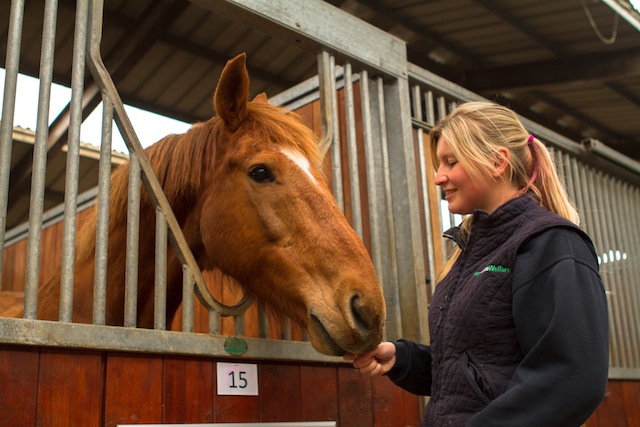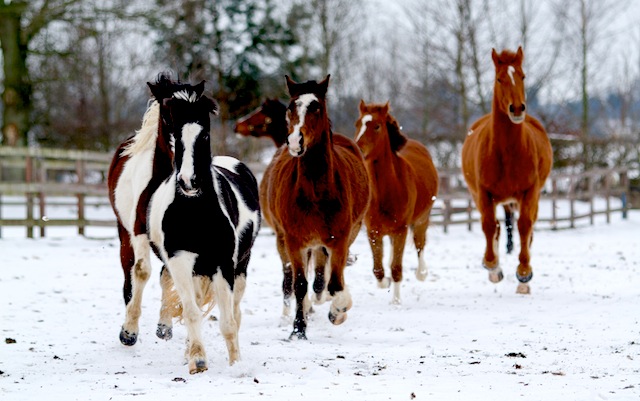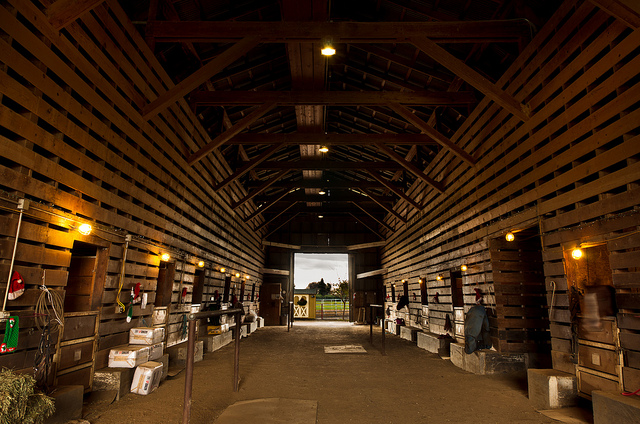Reverberating Research: World Horse Welfare Position on “Social” Stable Study
- March 10, 2017
- ⎯ Fran Jurga

The day after The Jurga Report had questions about a new British research study about equine welfare aspects of group horse stabling vs traditional stall options from Nottingham Trent University in England, World Horse Welfare chimed in, calling for a more open debate on both box and group stabling’s benefits and pitfalls.
In the study, researchers tested stress hormone levels in a group of 16 unworked horses as they were rotated between different types of stables or stalls that offered more or less social contact with other horses.
As it turns out, other people were moved to comment on the research, as well.
The publication of the research coincides with a revival of a rumor of possible legislation on horse stabling under European Union policy–legislation that might prohibit keeping horses in stalls, or regulate the maximum number of hours per day that a horse can be in a stall..
The researchers suggested that social accessibility with other horses should be considered an aspect to equine welfare.
“The stable wears out a horse more than the road does.”—French proverb
In the conclusion of the paper, the researchers stated, “Inadequate housing design could potentially cause stress and result in negative consequences on the health and wellbeing of domestic horses; however, it is one aspect of equine husbandry that could easily be altered. Group housing provides horses with an environment where they are able to display natural behavior and allows contact with con-specifics improving overall welfare. The behavioral and physiological findings during this study imply that the social housing designs were less aversive than the single housing design and provided an improved standard of equine welfare.”
The Jurga Report included some comments about different horse housing customs in the United States that readers might keep in mind when reading the research.
Today, World Horse Welfare (WHW) issued a press release calling for a more open debate on stabling in response to the research, which has been featured in prominent daily newspapers in Great Britain. World Horse Welfare has four horse facilities in Britain and uses a combination of box stalls and turnout/run-in sheds to house hundreds of horses.
WHW Chief Executive Roly Owers says: “World Horse Welfare welcomes this study as it supports what we have been highlighting for some time: poorly managed stabling can cause significant welfare problems.

“Whilst we believe that stabling does have an important and beneficial role to play in the wide variety of ways that we can manage horses in the UK today, this must be done responsibly. This study provides plenty of food for thought, although we should be mindful of not reading too much into any single piece of research, not least because horses are individuals and what suits one animal does not necessarily suit another.”
Deputy Chief Executive Tony Tyler says that the culture at World Horse Welfare’s four UK Rescue and Rehoming Centres encourages regular social interaction: “Most of our horses live out in groups with access to field shelters all year round. For those who need to be stabled we have large open-sided crew yards at each of the Centres where horses can be kept in small groups of up to three or four, and horses who are kept on their own can easily socialize over partitioning walls.

“However, it is sometimes necessary to keep our horses in stables for their own welfare but a combination of good management and constant assessment to make sure that all their needs are being met is essential to the mental as well as physical health of the horse.”
According to World Horse Welfare, some of the key issues to consider with stabling include:
- access to turn out
- social interaction
- the design of the stabling

World Horse Welfare remarked that it was encouraged that Julie Girling, MEP is producing a proposal on responsible equine ownership and care for the European Union, which will highlight the need for guidance on good stabling practices.
Roly concludes: “We should not lose sight of the key issue involved here, namely the needs that horses have for social interaction. It is totally unacceptable to house a horse all-day in a stable with both top and bottom door bolted; however we would also seriously question a horse kept out at pasture 24/7 without any companionship.
“Clearly, equine companionship is a great option but people and other animals can play a role here too. Above all, we hope that this research, published in a highly respected scientific journal, will promote an informed debate about the role that stabling can play in caring for our horses.”
At the end of this article, The Jurga Report offers a link to several additional papers that describe group horse housing more specifically, and two reference books that may be helpful to anyone interested in the welfare pro/con aspects of keeping horses in stalls.
A Danish study of group-housed vs stall-housed horses found that the horses living in stalls were more interested in interacting with humans than group-housed horses. During training, however, stall-kept horses were more likely to exhibit hostile behavior like kicking.
In the Swedish review paper “Keeping Horses in Groups” by Hartmann et al, the authors acknowledged that not enough scientific study had been done on housing alternatives for horses, compared to other farm animals, because horses are kept for leisure purposes rather than raised for profit sale, production, and turnover.
The authors regretted that the leisure aspect in the equation might hinder objectivity in decision-making that ultimately affects horses.
To learn more:
Domesticated horses differ in their behavioral and physiological responses to isolated and group housing by Kelly Yarnell,Carol Hall,Chris Royle, and Susan L. Walker inPhysiology & Behavior, May 2015.
Keeping horses in groups: A review by Elke Hartmann, Eva Sondergaard, and Linda J. Keeling in Applied Animal Behavior ScienceVolume 136, Issues 2–4, 31 January 2012, Pages 77–87
The proceedings of the Equine Infrastructures conference in France in 2014 includes several papers on group housing of horses including these:
Injuries in group kept horses by C. M. Mejdell, G. M. Jorgensen, L. Kelling, J. W. Christensen, K. E. Boe
Effects of feeding management and group composition on agonistic behaviour of adult horses in group housing systems by J.-B. Burla, A. Ostertag, A. Patt, E. Hillmann, I. Bachmann
Keeping horses in groups – is separating horses for riding or training purposes a problem? by K. E. Boe, G. H. M. Jorgensen, C. M. Mejdell
Equine Behavior: A Guide for Veterinarians and Equine Scientists, Second Edition by Paul McGreevy, Elsevier Health Sciences 2012.
Equine Welfare by C. Wayne McIlwraith and Bernard E. Rollin, John Wiley & Sons, 2011








